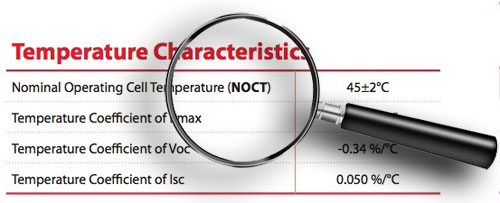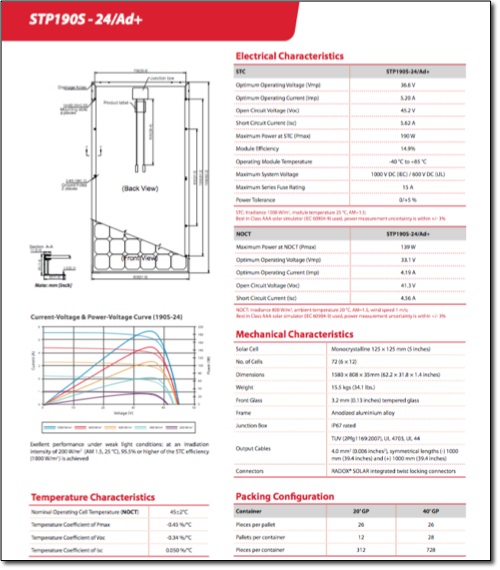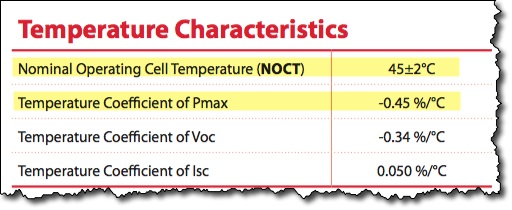Does a solar panel specification with “Max Power” rated at, say 190W, really produce a maximum power of 190W when it is on your roof in the blazing sun?
Short Answer: Not on your nellie!
The max power rating (in Watts) that your solar panels are rated at is the figure that everyone quotes when talking about “panel size”. If the installer or salesperson talks aout a “190W or 250W panel” they are talking about the “max power” rating of the panels. This rating is based on the power output measured from that panel under “Standard Test Conditions” (STC) that, unfortunately, are a long way from “Real World Operating Conditions”.
Under these STC conditions, the solar panel is subject to a light source (technical term: irradiance) measured at 1000W per square metre. That number probably means nothing to you, so you have to take it from me that 1000W/m² is the equivalent of a strong sun.
That in itself is not a problem, as last time I checked, the sun is pretty bloody strong in most parts of Australia. The problem is, however, that the STC power rating is based on a panel temperature of 25°C.
Think about that for a second. The panel temperature is the temperature that the actual solar panel itself will get to when it is on your roof. This temperature is critical because all solar panels lose efficiency as they heat up.
That means that the solar panel has to be no hotter than 25°C to produce its rated max power. Unfortunately a solar panel on your roof will generally be 20° hotter than the ambient temperature (it’s a big black panel sitting on the roof – it’s gonna get hot!). That means that the ambient temperature for an STC test must be only a rather chilly 5°C.
When was the last time you were in strong sun and the mercury was only at 5°C?
Cowboy Salesman Trap #1: Ask him what ambient temperature the module will produce its rated power at. If he says 25°C, push him out of the door!
So unless you live in a very sunny, cold place, you are never going to get the rated power out of your panels. Sorry about that.
The good news is that you can quickly work out how much power you will get in the real world, if you are brave enough to look at the solar panel’s specification sheet (also known as its data sheet). All reputable solar vendors will provide this as part of the quote.
Cowboy Salesman Trap #2: Kick him out if he can’t or won’t provide a solar panel specification sheet for your solar panel that looks something like this:
Here’s how to work out the real max power output of your solar panels from the solar panel specification sheet:
First look for the part of the solar panel specification sheet that contains the “Temperature Characteristics”. And look for the both the “Nominal Operating Cell Temperature”(NOCT) and the “Temperature Coefficient of Pmax“. I’ve highlighted them on this specification for a Suntech panel (STP190S-24/Ad+):
The NOCT is the temperature that the panel reached in the lab when subjected to 800W/m² of irradiance (moderate sun) at an ambient temperature of 20°C. So it’s a much more realistic measure of the temperature that your panels are actually likely to operate at. Here you can see that our panel will get to 45°C.
All solar panels reduce their power as they heat up. The “Temperature Coefficient of Pmax” tells us how much power it loses for every °C that the panel is hotter than 25°C (Remember that 25°C is the panel temperature that the STC power is measured at). The Suntech panel above will lose 0.45% of its max power for every degree above 25.
The NOCT has told us that the panel will typically sit at 45°C so it is a simple sum to work out the power loss at this temperature:
(45°C-25°C) x -0.45%/°C) = 20 x -0.45% = -9%
So expect the real max power out of the panel to be 9% lower than the panel’s rated power. The Suntech STP190S-24/Ad+ is a 190W panel, so I would estimate its real world max power to be approximately 91% x 190W = 172.9W.
This is a much better number to use for solar panel comparison than the STC rated max power, because it takes into account the temperature performance of the panels, which is important Down Under! In fact in the USA the power we have just calculated above is on most solar panel specs and is called the PTC power (which stands for PVUSA Test Conditions). And even better than that, if the panel is approved for use in California, they actually measure the PTC power in a lab so that they don’t have to rely on the manufacturer’s numbers to calculate the PTC power. When they started doing this in 2009 they found that the real numbers were worse than the manufacturer’s claimed specs by an average of 6%. Check out the comparison tool I’ve put together that lets you compare the PTC of solar panels approved for use in Australia and California, if you need to compare panels before buying.
If you are interested in how the Suntech panel we used for our example tested in the lab, you can see the Californian Test results here. It actually tested to have a PTC of 171.5W, pretty damn close to the 172.9W calculated above. This goes to show how reputable brands like Suntech are gonna give you accurate numbers, but if you are buying your no-name panel from “Dodgy Bros” you might want to take the specifications with a pinch of salt.
>> Read part 2 of this post which shows you how to interpret ‘Power Tolerance’ and ‘Efficiency’ on a solar panel specification.




 RSS - Posts
RSS - Posts



Hi Finn,
I know that you aren’t real keen on thin film panels, but I thought you might be interested to know that, my 2.47kW thin film CIGS system, which regularly produces over 3000W of power even on days that are over 25 degrees and I’ve seen it up to 3300W (I have a SMA SB3800 inverter). They have a temp coefficient of about 0.31%, but I think the main reason for this performance is due to their claimed ‘light soaking’ capabilities.
Overall outputs seem to be pretty good so far too with around 4.5kWhr/pkW near Melbourne, so temperature coefficient isn’t everything and there are exceptions to the rule.
So although you are generally correct on temp coefficient, you may want to be careful who you kick out the door.
Cheers
Aaron
TSM-250PC05A.08 (60 Poly cells) from Changzhou Trina Solar Energy
Its NOCT is 46C and Temperature Coefficient of PMAX is -0.41%/°C.
46°C-25°C) x -0.41%/°C = 21C x -0.41%/°C = -8.6%. STC x (100%-8.6%)= 228.5w
This calculated power is very close to reported PTC.
While this panel has a high PTC and PTC/STC ratio, its max power at NOCT is actually low at 183.
Which is more reliable in assessing hot weather performance, Temperature Coefficient of PMAX, PTC (from spec sheets or independent lab) or max power at NOCT?
Thanks
If max power at NOCT is the better index, can you change your comparison tool to enable users to compare by that parameter?
Great Idea – It’s on the to do list for the next update!
Interesting… can you send me the link to the spec sheet that gives that max power at NOCT?
http://rfisolar.com.au/media/downloads/pdfs-solar/tsm-235pc05.10-mc4_datasheet.pdf
It appears that only newer PV models have this parameter on their spec sheets.
The Samsung LPC250sm max power at NOCT (usually @45-46C) is 200W on its spec sheet. That is much higher than I would expect with a NOCT of 46C and temperature coefficient of -0.48. By comparison PV-MBA1CG250 with a NOCT of 45C and more favorable temp coefficient of -0.438, has a max power at NOCT of 182W on its spec sheet. The California measured PTC (@20C) is 255.6W for both!
The California testing at 25C suggest similar performance. The calculations from NOCT and temperature coefficient suggest that the PV-MBA1CG250 is better in the heat. The max power at NOCT (45-46C) suggests that the LPC250sm is better in the heat.
Can you help me understand this?
Finn, I made a slight error. The PTC rating temp is 20C not 25C. Can you edit my statement?
I wrote to Samsung and at first they only said that they no longer produced the LPC250SM. I wrote again and asked if the 200 W at NOCT was a typographical error and they said yes! You can delete the replies mentioning the amazing LPC250SM max W at NOCT!
How does the roof temperature compare with the “ambient temperature”? This is important because one can use the following online tool to calculate the temp of the PV module from its NOCT and the ambient temp:
http://pvcdrom.pveducation.org/MODULE/NOCT.htm
At an ambient temp of 29.4C (85F) with a NOCT of 45C (representative of better PV panels), the calculated pv module temp is 54.5C. That is about 10C higher than NOCT, 30C higher than the STC rating temp (25C) and 35C higher than the PTC rating temp (20C). If the roof temps in hot sunny areas are even higher than “ambient temp” (presumably ground level), the module temps may even be higher.
The next question how to calculate power production from this calculated module temperature. If the maximum temp at NOCT is reliable, I would draw a line (or do linear regression) to determine the slope between power at PTC (20C) and power at NOCT (~46C).
Then I would extrapolate to the calculated module temp to estimate power at that temp. However, is the maximum temp at NOCT, as reported by the manufacturers, reliable?
http://www.epa.gov/heatisland/resources/pdf/GreenRoofsCompendium.pdf
“…conventional rooftop surfaces can exceed ambient air temperatures by up to 90°F (50°C).”
Liu, K. and B. Baskaran. 2003. “Thermal performance of green roofs through ield evaluation.”
National Research Council of Canada-46412. (available in Google Scholar)
Is it much different 4 inches above the roof where the panels are mounted?
before purchasing a solar controller, as the last one i had was a bunch of crap i would like to know if you could steer me into some advice.
my solar panel numbers are
max system volts – 600v
PMAX – 54W – 38W
VPMA – 17.4V – 15.3V
IPMAX – 3.11A – 2.49A
VOC – 21.7V
ISC – 3.31A
CLASS C.
first off i don’t understand what all those ratings and numbers are for, so i cant figure out what controller is best for this panel, the panel was bought at a Rona store in Canada, its about three feet square, and seems to be good, just need a great controller.
what i do with the deep cycle batteries is go lake trolling, i had all kinds of issues with the last controller i had cause it would float between 10 amps, low kick in and 12.7 high input shut off, that may sound good but i have been told numerous times and it stands true that when using a deep cycle for an electric out board one must start the day off with a battery with 13.3 or so full charge,
i do believe that,
so, i see there is controllers out there that are adjustable so one could set the low to 13. and the high to 13.2 etc and really keep ones battery totally topped off.
what range controller or input and or out put is it i require for this size panel
any advice you could give is truly appreciated and ya if you sell the adjustable controllers super,
thanks
pete
Hello guys,
I’m wondering about the efficiency of SUNTECH manufacture, I’m planning to buy one of the following models:
STP285S- 20/Wfw
STP280S – 20/Wfw
STP275S – 20/Wfw
I looked into specification of NOCT of 285W panel :
Maximum Power at NOCT (Pmax) 210.4 W
Optimum Operating Current (Imp) 7.16 A
and
Nominal Operating Cell Temperature (NOCT) 45±2°C
Temperature Coefficient of Pmax -0.41 %/°C
I think the there’s a huge difference between the STC rated and NOCT.
Do you recommend this panel ?
Hi Ali, Ronald here.
The NOCT appears low for the Suntech STP285S as it is only 73.8% of its output at STC but this is a result of the way the NOCT is done. You will get a similar result from all tier one panels around its price point.
If you are willing to pay extra for premium panels then you can get a better result but it won’t be massively better. For example the SunPower X21 345 has a Temperature Coefficient of Pmax of -0.29% and under NOCT its output is 77.7% of what it is under STC.
Over on the Markets Live site on the Sydney Morning Herald blog site there has been a discussion of this topic. People continue to insist that solar panels output increases on hot days.
I’ve given up on trying to convince that output falls as panels get hotter.
Even one the bloggers claims to be a physicist. I’ve thought about directing to this site, but they wouldn’t believe the data anayway.
What does E/0 stand for on my motor home solar panel?
I think it works, as it actually shows other numbers on sunny day
I’m guessing that’s a readout of how either many watts it is producing at the time or how many watt-hours it has produced through the day. If it is higher when the sunlight is strong and lower when the sunlight is weaker it’s watts. If the E stands for Energy then it would be watt-hours and would be a total of how much energy it had produced through the day and should increase until the system shuts down at sunset.
Here’s some real life figures. Make of them what you wish. They are true.
Installed in 2011
16 x 190W SunTech panels = 3.040W
(2KW facing north. 1Kw facing west)
TL4000 SunnyBoy inverter
Current reading 46,600KW today.
That’s about 1350Kw pa per 1KW of panels.
Seen peaks of 2950Kw instant last month
Seen plenty of days this year with 18-20Kw daily production
Not bad after 11 years!
Payback period was about 8 years for me with 44c FiT.
I also have a 1Kw system installed in 2008. Similar performance. Sadly the Sunnyboy inverter has died. Not bad. 14 years instead of 10 years expected.
Payback period about 9 years.
Pity the lot is all going to the dump.
Short story (after weeks of homework and research), is it is best to replace the lot with new 5Kw inverter and new 6.64KW new panels. All fit north facing.
I’m an accountant and do my own calculations. Forget some of those sales calcs – very misleading.
And after a battle I keep my 44c FiT!